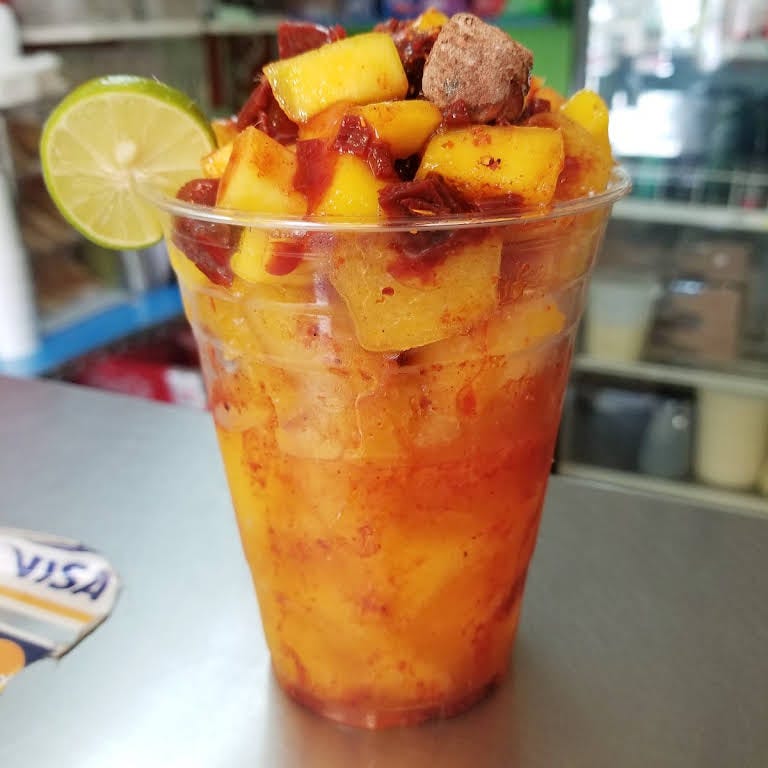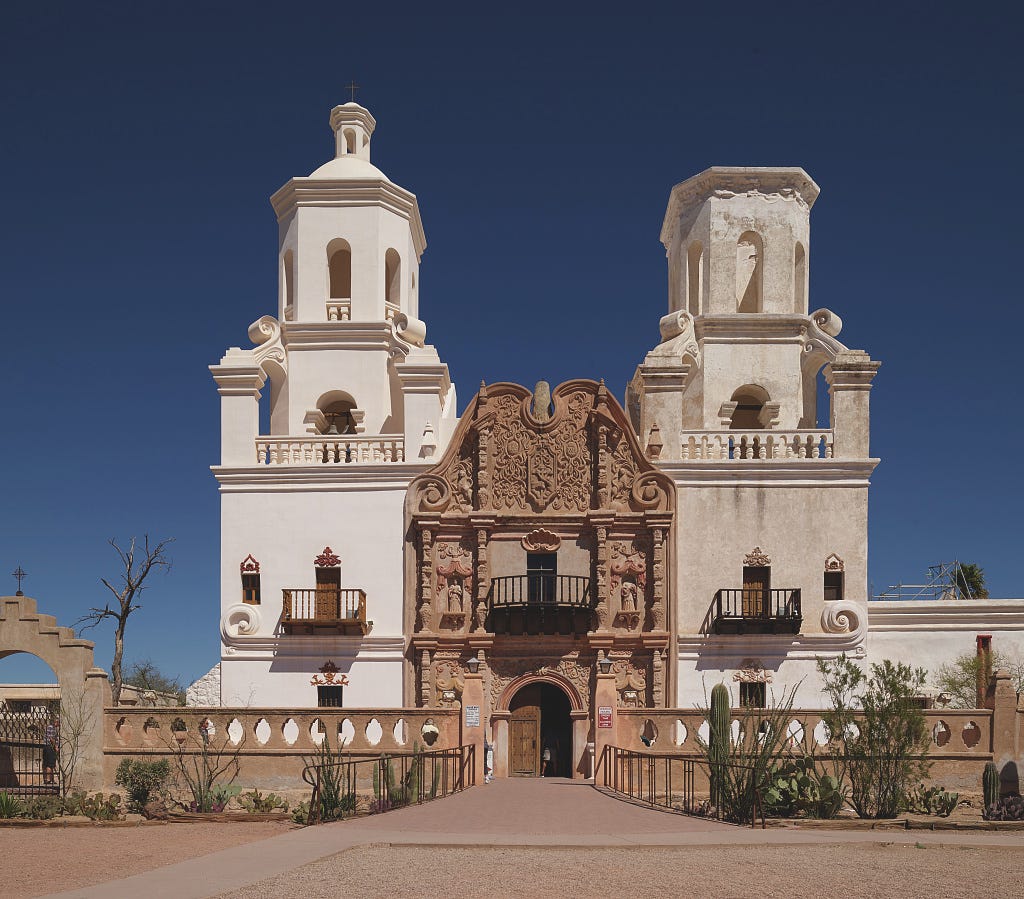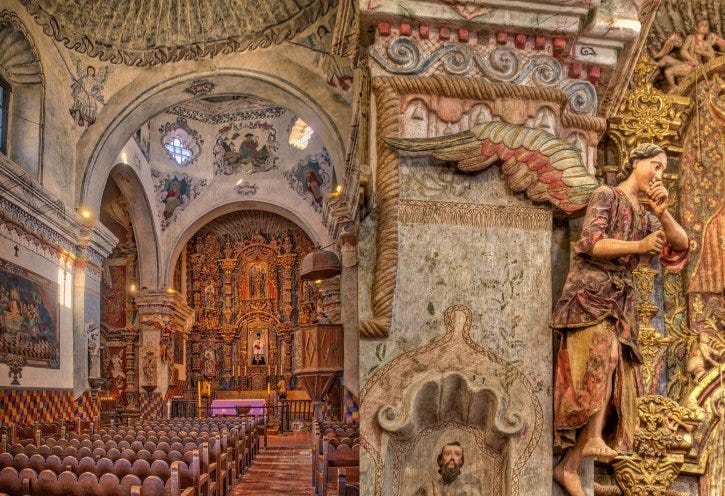Today’s newsletter brings context to Tuesday’s post, The Molino, which presented Popover, a story from Mele Martinez’s memoir.
V1/E 4
Table of Contents:
The San Xavier del Bac Mission on the Tohono O'odham Reservation
Popover’s Cat and Mouse
Where Did Native American Food Go?
Navajo Grandma’s History of Frybread and Recipe
From the Speak Your Mind Dept.
The Parting Glass
The San Xavier del Bac Mission on the Tohono O'odham Reservation
A (literally) torturous timeline
1692: The mission was founded by a Jesuit priest, Father Eusebio Kino, for the conversion of the Tohono O'odham.
1700: Father Kino builds a temporary church but doesn’t stay at the mission and leaves no one to tend it.
1711: Father Kino dies.
1756: Father Alonso Espinosa takes over the mission and, finding Father Kino’s church dilapidated, begins to organize the tribe’s 270 members to make repairs. They eventually refuse to work after Father Espinosa forbids their harvest festival to take place.
1767: King Carlos III of Spain, suspicious of the Jesuits’ success and apparent wealth, exiles all Jesuit priests from Spanish territories. Many die trying to return to Europe.
1768: The mission’s first Franciscan minister, Friar Francisco Garcés, arrives. He finds the mission in great disrepair but lacks the resources to make improvements.
1770: Apache, Seri, and Pima tribes attack the mission and destroyed the church. Four friars and more than 100 soldiers are killed. Seventy-four women and children are taken hostage.
1776: Friar Juan Bautista Belderrain is placed in charge of the mission. He secures a loan of $7,000 pesos from a local rancher to build a new church.
1783: Construction on the new church begins using Tohono O’odham laborers.
1790: Friar Belderrain suddenly hemorrhages blood and dies. He is replaced by Friar Juan Bautista Llorens, who continues construction for seven more years. He’s particularly interested in the church’s interior and employs painters and wood carvers. Statues are important from artisans in Mexico.
1797: With funds running out and creditors demanding repayment, work stops, leaving the east bell tower incomplete.
1828: Mexico, liberated from Spain, begins to deport all Spanish-speaking priests.
1837: The last Franciscans leave the mission. For the next ten years, the church remains empty except for rare visits from circuit-riding Mexican priests. The surrounding tribes try to keep the church in repair but portions of the façade begin to decay. Interior frescos and plasterwork fade, many of the wooden statues and ornate fretwork dry and crack.
1859: The Diocese of Santa Fe and the Bishop of Santa Fe take over the administration of the mission and begin to make necessary repairs. But they fail to find clergy to serve full-time at the mission and services are held sporadically.
1866: The situation improves when Tucson becomes an incipient dioceses and additional clergy are available for the mission.
1872: The Sisters of St. Joseph of Carondelet open a school at the mission for the first time.
1913: The Franciscan order returns to the mission and builds a new school overseen by the Franciscan Sisters of Christian Charity.
1992: Extensive renovations begin and are on-going. The interior has been restored to it’s original state and the exterior is in the final stages of a complete overhaul.
Today: Now considered the finest example of Spanish Colonial architecture in the country, the mission and Franciscan order continue to serve the Tohono O’odham community.
The Molino’s Cat and Mouse
A telling detail in Mele Martinez’s story, “The Molino,” is her father pointing out to her and her brother the carving of a cat and a mouse:
My father always points at the mission’s façade and retells the same ancient tale, but in his own tongue full of enigmatic doublespeak. “You see the cat and mouse?” he says, not really asking.

“I can’t see it,” I say.
“Where?” Ricky asks.
“Open your eyeballs,” my father badgers, pointing a crooked finger at the elaborate carved adobe and landing his heavy hand on the crown of our heads to force our gaze up higher. Eventually, we find the sculptural details: a skinny cat, an elusive mouse emerging from the baroque background.
“When the cat catches the mouse, the world will end,” he says, resigned like a prophet.
“How’s it gonna catch the mouse?” Ricky asks, loud and suspicious. There is never a clear answer. All that seems to matter to my father is the story, the words repeated like an incantation.
Where Did Native American Food Go?
Missionaries considered changing Native Americans’ diet to be part of their religious conversions. It has been estimated that, at the time missions such as San Xavier del Bac were being established, Native American tribes harvested over 2,000 different plants, some domesticated, others foraged. What truly destroyed their diet, however, began in 1866 with the United States Army’s campaigns to remove tribes completely from their territories. Once they were pushed onto reservations, the tribes had no choice but to rely on government-issued provisions composed of highly processed grains, and canned meats and produce. They did the best they could to translate their traditional recipes, but the sub-par ingredients and lack of variety soon wreaked havoc on their health. The frybread—the popovers in Martinez’s story—sold in the makeshift arbor stalls in the mission’s parking lot is an apt example. It’s made of refined four and fried in lard but hard to resist, especially topped with something called red meat, a mystery since the meat’s color is due not to the animal it came from but the thick plaster of chili sauce surrounding it.
Navajo Grandma’s History of Frybread and Recipe
If you only have time for one visit with Navajo Grandma, choose the first video in which her grandfather tells the story of his people’s food experience when they were forced onto reservations.
And then come around again and she’ll help you mix up a batch of frybread.
From the Speak Your Mind Dept.
Bill Penzey on Disney and how they can undo the hatred behind Florida’s “Don’t Say Gay” law:
“My advice is, look to the life of Jack Kirby, the co-creator of Captain America and so many of the characters Marvel became known for. It’s in his unique ability to bring voice to his experiences facing discrimination, and seeing up close the destructive power of nationalism on the front lines of WWII, that the heart and soul of the Marvel films the world fell in love with can be found. In his day he delivered so well the notion that discrimination against any American was discrimination against every American. That’s the voice we need now.”
Read his full statement in Penzeys spices latest catalog.
The Parting Glass
Raspados

The first raspados I tasted was on South Sixth Avenue, a somewhat busy Tucson road where, come lunchtime, various food trucks line up, bumper to bumper, on the shoulder. After eating my way from truck to truck, through piles of tortillas, Estilo Sonoras, and bowls of menudo, I happily ended up at a truck dedicated to raspados. You will recognize it as a basic snow cone doused in a sweet fruit syrup. Then you dig into the diced fruit on top with its sprinkle of ruthless chilis and quickly realize you better dig faster through a dollop of the optional vanilla ice cream (or coconut milk) to the shaved ice. Then you have to try another flavor because the sun is vicious and there’s no shade along South Sixth Avenue, and, in any case, raspados has become your new favorite food of all time. Gratefully, it’s not hard to make at home—the ingredients are composed of shaved ice, ice cream or coconut milk (both are optional), and some kind of fruit, partly reduced to a sugary syrup and partly diced for the topping. In theory, you can take control of the amount of chili you top raspados off with, but it’s not the same if you’re too light-handed.
First, make the syrup—this is a traditional favorite, tamarind syrup. The recipe will work for any fruits you prefer to substitute.
1/2 pound dried tamarind pods in their shell
1 cup boiling water
1 cup granulated sugar
1 tablespoon freshly squeezed lime juice
Break the pods and remove the stems beneath the outer shell that connect the seeds and pulpy parts of the inner pod.
In a medium saucepan, mix the seeds and pulp with the water and sugar. Cook over high heat and stir continuously so that the sugar dissolves.
Reduce heat to medium-low and use a potato ricer or mortar to smash up the pulp, which will begin to dissolve into the sugar syrup. Continue mashing until the seeds are separated from the pulp and the solution has become syrupy.
Strain the syrup into another container using a fine sieve to remove the seeds and pulp. The syrup should be thick and opaque, but not pulpy. Strain a second time to remove any particles and mix in the tablespoon of lime juice.
Pour into an air-tight container. The syrup will keep for up to three weeks.
Now you’re ready to construct a raspados.
Enough shaved ice to fill the cup you’re using 3/4 of the way up
one scoop vanilla ice cream (optional)
diced fruit—any will do, but especially pineapples, mangos, papayas, and berries
syrup
ground chilis or Tajin
Fill a cup 3/4 up with shaved ice. Add a scoop of ice cream, then pile on the diced fruit. Liberally pour in the syrup, then sprinkle a good amount of chili powder or Tajin over the top.
Dive in with a spoon or fork but never a straw.
Tucson Foodie offers a good guide to where to find the best raspadas in Tucson.





